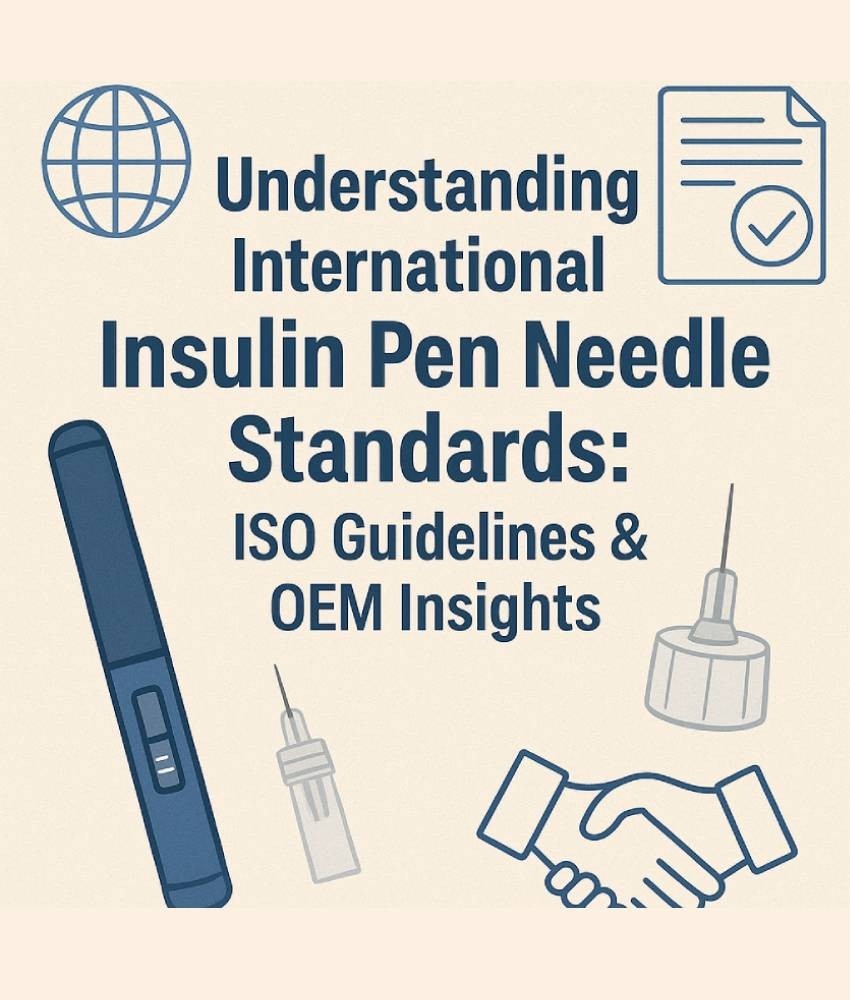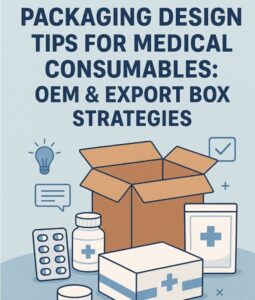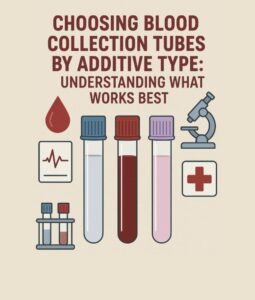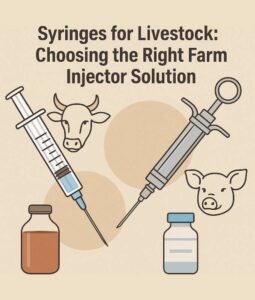Introduction: The Global Need for Pen Needle Standardization
As diabetes continues to affect millions worldwide, the demand for safe, effective, and universally compatible insulin injection systems has never been higher. Today’s healthcare providers and manufacturers must adhere to the latest insulin pen needle standard, ensuring that products not only meet performance expectations but also comply with internationally recognized ISO pen needle guidelines. Behind the scenes, every high-quality diabetic pen OEM plays a crucial role in delivering compliant and innovative solutions that serve both clinical and personal care settings.
This article explains everything manufacturers, distributors, and medical professionals need to know about pen needle standards, international regulations, and what to expect from compliant OEM partnerships. Know more..
What is an Insulin Pen Needle Standard?
Definition and Purpose
An insulin pen needle standard is a regulatory benchmark established to ensure safety, performance, and interoperability among insulin delivery devices. These standards define:
- Needle gauge and length tolerances
- Bevel sharpness
- Lubrication consistency
- Packaging integrity
- Compatibility with multiple insulin pens
The overarching goal is to safeguard patient health while supporting seamless global distribution.
Impact on Patient Safety and Device Interoperability
Without standardization, patients could face:
- Needle breakage
- Leakage during injection
- Compatibility issues between pens and needles
- Inconsistent insulin delivery
Standards help streamline training for clinicians and reduce the likelihood of user error.
Understanding ISO Pen Needle Regulations
Key ISO Standards: ISO 11608 Series
The ISO pen needle standard is most commonly defined under ISO 11608, which outlines essential safety, performance, and labeling criteria. Key parts of this series include:
- ISO 11608-1: General requirements for needle-based injection systems
- ISO 11608-2: Needles – dimensions, strength, lubricity
- ISO 11608-3: Human factors and usability testing
- ISO 11608-5: Automated functions
These are globally recognized and mandatory for regulatory approval in Europe, North America, and many Asian markets.
Technical Requirements for ISO Pen Needle Compliance
To meet ISO, the needle must:
- Penetrate skin without bending or breaking
- Deliver accurate dosing with minimal resistance
- Be sterile and safe for one-time use
- Fit across brands like NovoPen, FlexPen, KwikPen, and more
Design and Engineering Parameters under Global Standards
Needle Gauge, Length, and Sharpness
Common sizes under ISO include:
- Gauge: 29G to 33G (thinner needles = less pain)
- Length: 4mm, 5mm, 6mm, 8mm, and 12mm
Sharpness is evaluated by measuring insertion force. ISO requires consistent penetration performance across batches.
Lubrication and Bevel Geometry
Lubricants like silicone reduce pain during insertion. Needles typically feature:
- Tri-bevel or quad-bevel designs
- Uniform coating thickness
- Minimal drag and skin trauma
Compatibility and Interchangeability
ISO Fitting Standards Across Brands
One of the most critical functions of the insulin pen needle standard is ensuring universal fit. All ISO-compliant needles must:
- Use standardized screw or push-fit hubs
- Fit major pens without modification
- Prevent leakages or injection failures
How OEMs Ensure Universal Pen Fit
Leading diabetic pen OEM companies:
- Use ISO-certified molds
- Conduct pen compatibility tests
- Design hubs for low-tolerance variability
This guarantees that patients can switch pens or needles without performance loss.
The Role of Diabetic Pen OEMs in Standardization
OEM Manufacturing and Certification
Every quality diabetic pen OEM operates under:
- ISO 13485 for medical devices
- CE and FDA registrations
- In-house QA systems that align with ISO 11608
How OEMs Customize While Remaining ISO-Compliant
Customization includes:
- Private label branding
- Custom bevel angles or gauge combinations
- Multi-language instructions
However, these modifications must not violate ISO core standards or compromise functionality.
Sterilization and Packaging Guidelines
EO Sterilization and Shelf Life Control
ISO-compliant pen needles are typically sterilized using ethylene oxide (EO). Key requirements include:
- EO residual testing
- Verified 5-year shelf life
- Tamper-evident seals
Tamper-Proof and Multi-Language Packaging
Packaging must clearly display:
- Needle size and compatibility
- Sterility indicators
- Manufacturer and batch details
Multi-language IFUs (Instructions for Use) are a must for international compliance.
Labeling, Barcoding, and Regulatory Data
What Information Must Appear on ISO-Compliant Labels
Labels must include:
- Manufacturer name and address
- UDI (Unique Device Identifier)
- Expiry date and sterilization method
- Gauge/length and usage instructions
UDI and Global Traceability Integration
UDI requirements align with:
- FDA GUDID database (U.S.)
- EUDAMED (EU)
- China’s UDID system
UDI codes ensure traceability across the supply chain, from factory to end-user.
Quality Control and Manufacturing Best Practices
In-Line Inspection and Batch Testing
Every diabetic pen OEM should follow:
- 100% in-line visual inspection
- Random needle strength and sharpness testing
- Bioburden and sterility validation
Meeting International Audit and Certification Requirements
Facilities are subject to:
- Third-party audits
- Regulatory inspections (FDA, TGA, NMPA)
- Periodic re-certification
These measures build trust with hospitals and distributors worldwide.
How ISO Standards Benefit Healthcare Providers and Patients
Reduced Training Needs for Nurses and Pharmacists
When all needles follow the same standard:
- Training becomes uniform
- Staff can use any brand with confidence
- Workflow efficiency improves
Improved Patient Trust and Device Usability
For patients, ISO standards guarantee:
- Consistent injection feel
- Reduced pain
- Compatibility with their prescribed pen
This builds adherence and long-term diabetes control.
Challenges in Meeting and Maintaining ISO Compliance
Cost of Certification for Diabetic Pen OEMs
- ISO audits and testing are expensive
- Recertification is required every 2–3 years
- Some OEMs struggle with documentation demands
Despite costs, maintaining compliance is essential for market entry and user safety.
Regional Variations in Enforcement
While ISO is global, enforcement varies:
- The EU enforces strict MDR rules
- The U.S. has device registration and labeling rules via the FDA
- Asia and the Middle East increasingly follow IMDRF frameworks
Future of Insulin Pen Needle Standardization
Smart Needle Integration
Expect more smart solutions including:
- Sensors in pen needles
- Dose-tracking systems
- Bluetooth UDI scanning
ISO will expand to address digital compliance and smart connectivity.
Sustainability and Eco-Standards in Packaging
Eco-conscious manufacturing is on the rise. OEMs now explore:
- Biodegradable needle caps
- Recyclable blister packs
- Reduced plastic usage
New ISO extensions may soon address environmental sustainability in disposable medical products.
FAQs: ISO Pen Needle & Diabetic OEM Supply Chain
1. What is the minimum requirement for insulin pen needle standard compliance?
At minimum, compliance with ISO 11608-1 and ISO 11608-2 is required for clinical and commercial use.
2. Can a diabetic pen OEM customize product features and still meet ISO?
Yes, as long as core parameters (fit, sharpness, sterility) remain unchanged.
3. Do all insulin pens accept ISO pen needles?
Yes. ISO-compliant needles fit most major pen brands through standardized hub designs.
4. How is sterility maintained in shipping?
Needles are EO-sterilized, sealed in tamper-proof packaging, and shipped in temperature-stable cartons.
5. Is UDI mandatory for pen needles?
Yes, in many regulated markets. It ensures traceability and patient safety.
6. How do I verify if a pen needle is ISO-certified?
Check the packaging for ISO symbols, regulatory numbers, and ask your OEM for test reports or declarations of conformity.
Conclusion
From performance to compatibility, the insulin pen needle standard ensures safer injections, better patient outcomes, and seamless supply chain integration. Global adoption of ISO pen needle regulations helps align diabetic care across regions, while top-tier diabetic pen OEM suppliers enable clinics and distributors to deliver high-quality, private-label solutions with confidence.
As technology and compliance evolve, working with certified partners who understand ISO intricacies will be key to success in the future of insulin delivery.






